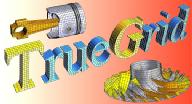TrueGrid® Imports Trimmed Surfaces From Solids Modelers
Now engineers can enjoy the benefit of rapid prototyping using a solids modeler, and convert this model to a classical surface and curve model to do analysis. IGES is an ideal format for the resulting surface and curve model and is indispensable in a concurrent engineering environment. Engineers, draftsmen and technicians can all work from the same database.
Insist on full support for Trimmed Surface
Solids modelers typically export all the surfaces used to create solid pieces. A sphere with a hole through it becomes a sphere and a cylinder; and the cylinder almost certainly extends beyond the sphere. Planes used to slice to the model are exported, and they are not confined to the region of the solid. The way that the original model is reproduced is with both the surface model, and with curves used to trim away the excess parts of the surface. Some curves trim away pieces around the edges of a surface, and others cut holes in the surface.
TrueGrid gracefully deals with typical models built using hundreds of complex trimmed surfaces, any of which may have tens of holes and a hundred or more trimming curves. No surface editing is required--even "multiply-trimmed" surfaces are ready-to-use.

|

|
|
does not support trimming |
|
TrueGrid displays a faithful reproduction of the solids model. TrueGrid detects what is left of the surface, and can prove it to you on the screen. TrueGrid users can even combine such surfaces into one object, making them more complex. And TrueGrid is fault tolerant, so it doesn't matter whether or not the surfaces meet precisely.
Combining surfaces into one is a powerful feature of TrueGrid. The CAD operator is not bothered by details of how surfaces are used. The TrueGrid mesh does not depend on how geometry is made, only on the actual shape of the geometry.

| Filleted areas are commonly decomposed as shown. Just the single tab shown here is composed of 16 surfaces. It is critical to be able to combine such surfaces into one to avoid spending disproportionate amounts of time on small features. |

|
| Here is an example of a trimmed surface with 31 edges. Decomposing such surfaces into 4-sided surfaces is not only tedious, but unnecessary with TrueGrid. |

|
An Example - Combining Surfaces for Meshing

|
The outlines of a composite surface is shown. 23 surfaces were
selected with a single mouse operation in TrueGrid. The surfaces
were combined into one surface with one command. Even though the
surfaces do not meet perfectly, TrueGrid does not require them to
be altered in any way.
|
|

|
Left. A simple block part is constructed as a three-dimensional
array of blocks. Three delete operations carve away blocks
that will not be used. Right. Blocks are moved into a position which approximates the object. Some blocks appear to be missing because they are fully collapsed.
|

|

|
The appropriate outer faces are projected to the composite. Others
are projected to the front and back faces. TrueGrid automatically
intersects the composite surfaces; edges required to be on two
surfaces are automatically placed on the surface-surface intersections.
No curves are required.
|

Summary of Support for Trimmed Surfaces
- Imports trimmed surfaces (IGES type 144) from all solids modelers.
- Trims the surfaces for display, so you view a faithful reproduction of the solids model. No proprietary graphics libraries are required.
- Even the most complex surfaces with scores of holes and outer trimming curves are ready-to-use.
- The mesh does not depend on how the the original model is broken into surfaces.
- Trimmed surfaces may be combined into one. All TrueGrid features work for composite surfaces, including elliptic smoothing, projection, and automatic surface-surface intersections.
- TrueGrid has been tested on tens of thousands of
trimmed surfaces.

 Home Page
Home Page

Questions, comments, suggestions

Copyright © 1996-2013 XYZ Scientific Applications, Inc. All rights reserved.
